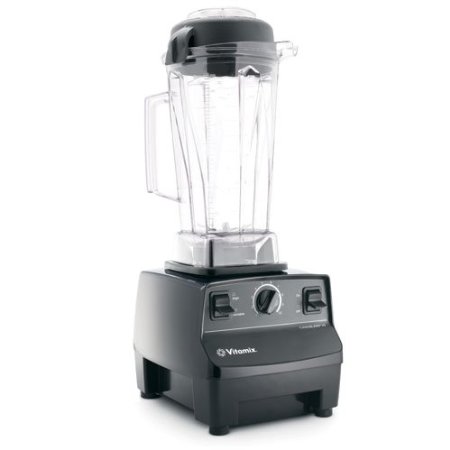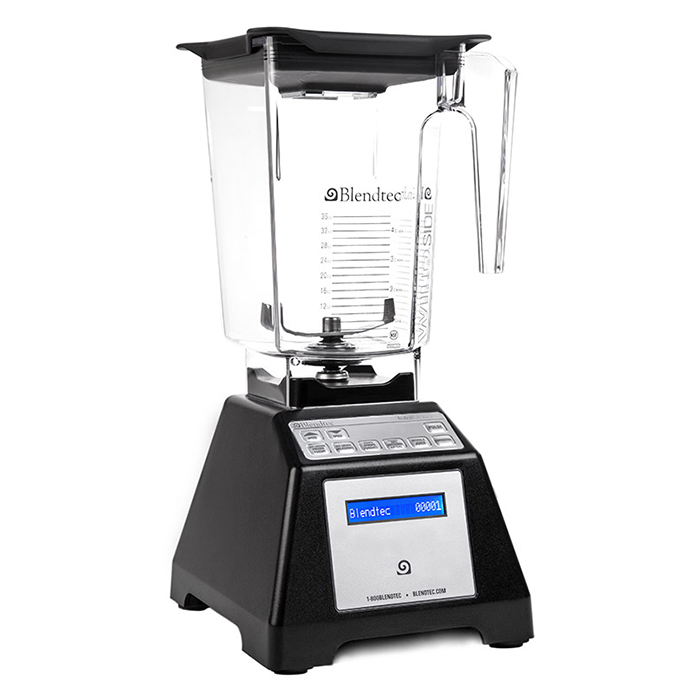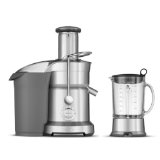Vitamix have a reputation of making solid blenders. But they’re also quite expensive. Is it really worth shelling out the extra money for one? I look more closely in my Vitamix reviews.
Note: Although Vitamix have lots of different models, all Vitamix blenders are the equal under the hood. They all use exactly the same motors, power supply, blades, assemblies and parts. This means their performance is identical.
At the end of my Vitamix reviews, I’ll compare the different models. The only differences come in the blending speeds (2 speed vs. variable) and the warranty length (3 vs. 5 years).
With this in mind, for my Vitamix reviews I examine the most popular one in the series, the Vitamix TurboBlend.
Vitamix TurboBlend
Vitamix TurboBlend
Click here for complete Vitamix TurboBlend specs
Advantages
First in my Vitamix reviews, its advantages:
+ It actually makes smoothies
There are thousands of blenders out there, but only a handful can actually make a smoothie. The rest give you something rough with huge clumps of fibers, chunks of ginger, pear skin etc.
While not impossible to drink, it’s still hard and takes all the fun out of smoothies.
Fortunately, the Vitamix doesn’t have this problem. Being the most powerful blender available for home use, it always returns perfectly smooth smoothies.
+ Efficient
Vitamix blenders are designed to be fast.
The motor is powerful, giving you 2 horsepower at its peak. It also has some of the sharpest blades I’ve seen in a home blender. This maximizes the cutting power delivered by its motor.
It also has a plastic tamping ‘plunger’ which can be used during operation. Firstly, it means that you don’t need to add water for things to start blending. And then if anything is stuck on the side and not getting blended, instead of waiting or shaking the unit, just use the plunger to push it into the path of the blades.
Amazingly, nothing flies out of the top while you’re using it. It’s also designed to stop itself before it reaches the blades, so you can be as aggressive as you want in tamping your smoothie.
+ Simple
Using the Vitamix TurboBlend is as simple as it gets. Simply switch it on and set it to ‘Hi’ or ‘Lo’. That’s it. If you’re using the 5200 / CIA model, then adjust the speed using the knob too.
+ Built to Last
Because of the huge force generated by its motor, there’s a lot of strain put on the entire unit. A vulnerable area would be the bearings and blade assembly, because this is where the ‘rubber meets the road’ - where the motor’s power is actually focused.
On all Vitamix’s, this is all metal. It’s also very heavy (located at the base of the container). This all means that it’s strong enough to withstand the forces of frequent use.
A nice surprise is that the blade and assembly can be removed from the container. So if you damage the container, you don’t need to shell out on a new blade and assembly as well. This will save you money.
+ Long Warranty
It’s possible that such a powerful motor could affect the life of the product. Vitamix are so confident that it won’t, they’re guaranteeing the TurboBlend for 5 years. Other models in the range have an industry leading 7 year warranty (listed at the end of my Vitamix reviews).
Disadvantages
For the second part in my Vitamix reviews, the disadvantages.
- Noisy
All blenders are noisy. And as you might expect from one of the most powerful blenders available for home use, this one is too.
However, Vitamix have done a really good job of dampening the noise. The container is thicker than Blendtec containers, which helps keep the noise down. It also sits on a rubber ‘silencer’ where it meets the base unit. This absorbs some of the vibrations, again keeping the volume low. This is another thing the Blendtec lacks.
The base is also purposefully weighted, which keeps it in place while blending. Other blenders will vibrate and even move around when blending very thick mixtures (e.g. peanut butter). This weight also helps to keep the noise to a minimum.
- Pricey
Vitamix’s aren’t cheap. The question you need to ask yourself before buying a Vitamix blender is: “Do I really want shop quality smoothies?”
There’s a reason why cheaper blenders aren’t up to the task - it’s because it takes a lot of power and engineering to get smoothies to the consistency you like.
This particular model, the Vitamix TurboBlend, is actually surprisingly affordable here.
Vitamix Reviews: Conclusion
Here’s the most important takeaway in my Vitamix reviews: all Vitamix blenders get the job done. Period. They make commercial grade smoothies, and are guaranteed for 5 or 7 years. This is where the extra money goes.
If you want something which is simple to operate, makes the most delicious smoothies you can have at home, and lasts for an age, buy the Vitamix.
- Save money on the Vitamix TurboBlend here.
Vitamix Reviews: Confusing Models
As I’ve mentioned at the start of my Vitamix reviews, they all use the same motors, blades, power supply and parts. They’re equally good at blending to a commercial level. The only differences are:
- Warranty length
- 2 speed / variable speed
Here’s the breakdown.
2 Speed + 5 Year Warranty
Variable Speed + 7 Year Warranty
Why do you need variable speed? If you want more control over the consistency of your produce. For example, if you want to make salsa or hummus.
- Vitamix 1732 TurboBlend VS Blender (here)
- Vitamix 1723 Professional Series 200 (here)
- Vitamix 1709 Professional CIA Series (here)
- Vitamix 5200 (here). Older model.
What’s the difference between these 4 models? Nothing, except for superficial things - different markings on the blender, and different recipe guides / books / DVDs thrown in. My advice - just go with the cheapest one. It’s the same blender.




Josh says
So I have a 5 year old Turboblend (2 speed) that was just returned to me from warranty service. It seems that during the warranty process, Vitamix replace the plastic cap above the motor and the stickerplate around the controls (front of base).
I notice now that Thee stickerplate seems to have a hollow part under it where the variable knob would be on the 5200. This got me to wonder…
Is my machine the same machine exactly as the 5200 (capable of being variable speed) but just missing the knob?
Is the low setting is actually a variable speed setting that is just fixed?
If so would it be possible to hack my Turboblend to put a knob on it and make it variable speed?
Has anyone else ever contemplated this? Anyone have any info on hacking the Turboblend?
DRT says
I have done a lot of reading and researching on which model to buy (5300 vs 7500) and I am left with just one question now: Do I honestly really need the 32 oz dry grains container? Vitamix maintains that should be used if mixing grains but some reviews say the wet container works just fine. I do make flour, nut butter and bread regularly. Help?
Thank you!